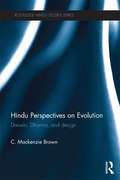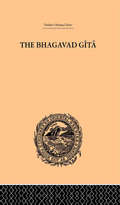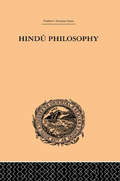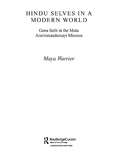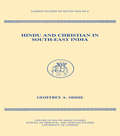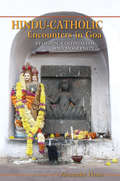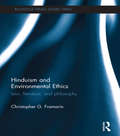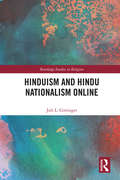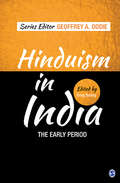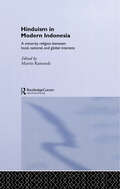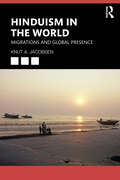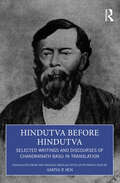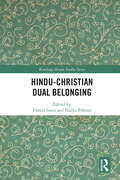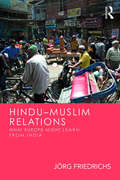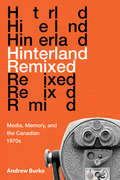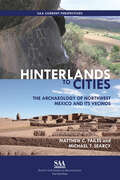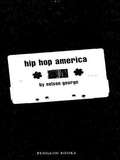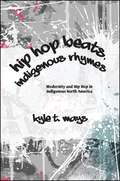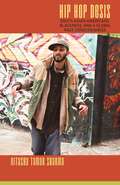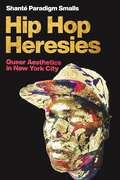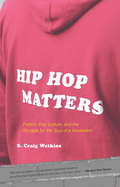- Table View
- List View
Hindu Perspectives on Evolution: Darwin, Dharma, and Design (Routledge Hindu Studies Series)
by C. Mackenzie BrownProviding new insights into the contemporary creationist-evolution debates, this book looks at the Hindu cultural-religious traditions of India, the Hindu Dharma traditions. By focusing on the interaction of religion and science in a Hindu context, it offers a global context for understanding contemporary creationist-evolution conflicts and tensions utilizing a critical analysis of Hindu perspectives on these issues. The cultural and political as well as theological nature of these conflicts is illustrated by drawing attention to parallels with contemporary Islamic and Buddhist responses to modern science and Darwinism. The book explores various ancient and classical Hindu models to explain the origin of the universe encompassing creationist as well as evolutionary—but non-Darwinian—interpretations of how we came to be. Complex schemes of cosmic evolution were developed, alongside creationist proofs for the existence of God utilizing distinctly Hindu versions of the design argument. After examining diverse elements of the Hindu Dharmic traditions that laid the groundwork for an ambivalent response to Darwinism when it first became known in India, the book highlights the significance of the colonial context. Analysing critically the question of compatibility between traditional Dharmic theories of knowledge and the epistemological assumptions underlying contemporary scientific methodology, the book raises broad questions regarding the frequently alleged harmony of Hinduism, the eternal Dharma, with modern science, and with Darwinian evolution in particular.
Hindu Philosophy: Bhagavad Gita or, The Sacred Lay
by John DaviesFirst Published in 2000. Routledge is an imprint of Taylor & Francis, an informa company.
Hindu Philosophy: The Sankhya Karika of Iswara Krishna
by John DaviesThis is Volume VI of ten in the Oriental series on India: Religion and Philosophy. First published in 1881 this book focuses on Hindu Philosophy- The Sankhya Karika of Iswara Krishna, an exposition of the system of Kapila, with an appendix that also includes the Nyaya and Vaiseshika systems.
Hindu Pilgrimage: Shifting Patterns of Worldview of Srisailam in South India (Routledge Hindu Studies Series)
by Prabhavati C. ReddyIn recent years, changes in religious studies in general and the study of Hinduism in particular have drawn more scholarly attention to other forms of the Hindu faith that are concretely embodied in temples, icons, artworks, rituals, and pilgrimage practices. This book analyses the phenomenon of pilgrimage as a religious practice and experience and examines Shrî Shailam, a renowned south Indian pilgrimage site of Shiva and Goddess Durga. In doing so, it investigates two dimensions: the worldview of a place that is of utmost sanctity for Hindu pilgrims and its historical evolution from medieval to modern times. Reddy blends religion, anthropology, art history and politics into one interdisciplinary exploration of how Shrî Shailam became the epicentre for Shaivism. Through this approach, the book examines Shrî Shailam’s influence on pan-Indian religious practices; the amalgamation of Brahmanical and regional traditions; and the intersection of the ideological and the civic worlds with respect to the management of pilgrimage centre in modern times. This book is the first thorough study of Shrî Shailam and brings together phenomenological and historical study to provide a comprehensive understanding of both the religious dimension and the historical development of the social organization of the pilgrimage place. As such, it will be of interest to students of Hinduism, Pilgrimage and South Asian Studies.
Hindu Selves in a Modern World: Guru Faith in the Mata Amritanandamayi Mission (Routledge South Asian Religion Series)
by Maya WarrierThis book explores devotional Hinduism in a modern context of high consumerism and revolutionised communications. It focuses on a fast-growing and high-profile contemporary Hindu guru faith originating in India and attracting a transnational following. The organisation is led by a vastly popular female guru, Mata Amritanandamayi, whom devotees worship as an avatar and a healer of the ills of the contemporary world. By drawing upon multi-sited ethnographic fieldwork among the mata's primarily urban, educated 'middle class' Indian devotees, the author provides crucial insights into new trends in popular Hinduism in a post-colonial and rapidly modernising Indian setting.
Hindu and Christian in South-East India: Aspects Of Religious Continuity And Change 1800-1900 (Soas London Studies On South Asia #No. 6)
by Geoffrey OddieFirst Published in 1995. Routledge is an imprint of Taylor & Francis, an informa company.
Hindu-Catholic Encounters in Goa
by Alexander HennThe state of Goa on India's southwest coast was once the capital of the Portuguese-Catholic empire in Asia. When Vasco Da Gama arrived in India in 1498, he mistook Hindus for Christians, but Jesuit missionaries soon declared war on the alleged idolatry of the Hindus. Today, Hindus and Catholics assert their own religious identities, but Hindu village gods and Catholic patron saints attract worship from members of both religious communities. Through fresh readings of early Portuguese sources and long-term ethnographic fieldwork, this study traces the history of Hindu-Catholic syncretism in Goa and reveals the complex role of religion at the intersection of colonialism and modernity.
Hinduism and Environmental Ethics: Law, Literature, and Philosophy (Routledge Hindu Studies Series)
by Christopher G. FramarinThis book argues that the standard arguments for and against the claim that certain Hindu texts and traditions attribute direct moral standing to animals and plants are unconvincing. It presents careful, extensive, and original interpretations of passages from the Manusmrti (law), the Mahābhārata (literature), and the Yogasūtra (philosophy), and argues that these texts attribute direct moral standing to animals and plants for at least three reasons: they are sentient, they are alive, and they possess a range of other relevant attributes and abilities. This book is of interest to scholars of Hinduism and the environment, religion and the environment, Hindu and/or Buddhist philosophy more broadly, and environmental ethics.
Hinduism and Hindu Nationalism Online (Routledge Studies in Religion)
by Juli L. GittingerThe way people encounter ideas of Hinduism online is often shaped by global discourses of religion, pervasive Orientalism and (post)colonial scholarship. This book addresses a gap in the scholarly debate around defining Hinduism by demonstrating the role of online discourses in generating and projecting images of Hindu religion and culture. This study surveys a wide range of propaganda, websites and social media in which definitions of Hinduism are debated. In particular, it focuses on the role of Hindu nationalism in the presentation and management of Hinduism in the electronic public sphere. Hindu nationalist parties and individuals are highly invested in discussions and presentations of Hinduism online, and actively shape discourses through a variety of strategies. Analysing Hindu nationalist propaganda, cyber activist movements and social media presence, as well as exploring methodological strategies that are useful to the field of religion and media in general, the book concludes by showing how these discourses function in the wider Hindu diaspora. Building on religion and media research by highlighting mechanical and hermeneutic issues of the Internet and how it affects how we encounter Hinduism online, this book will be of significant interest to scholars of religious studies, Hindu studies and digital media.
Hinduism in India: The Early Period (Hinduism in India)
by Geoffrey A. Oddie Greg BaileyA major contribution toward the ongoing debates on the nature and history of Hinduism in India Hinduism in India: The Early Period covers the major thematic and historical aspects of Hinduism in ancient and medieval India, emphasising primarily on belief structures, rituals, theology, art, and myths. Although the book focuses on the period from 200 BCE to 1200 ACE, the chapters make several references to ideas and practices preceding and following this period. This is a reflection of the fact that the cultural entity named "Hinduism" has been in a process of constant change and evolution, and continues to demonstrate many recognizably ancient elements even today.
Hinduism in Modern Indonesia
by Martin RamstedtThis book provides new data and perspectives on the development of 'world religion' in post-colonial societies through an analysis of the development of 'Hinduism' in various parts of Indonesia from the early twentieth century to the present. This development has been largely driven by the religious and cultural policy of the Indonesian central government, although the process began during the colonial period as an indigenous response to the introduction of modernity.
Hinduism in the World: Migrations and Global Presence
by Knut A. JacobsenThis book explores Hindu religion from a global perspective and investigates the presence of Hindu religious traditions and some of their diversity worldwide.Hindu traditions are on the move and are established in many new locations around the world, and old and new traditions are continuously changing and being invented and reinvented. The chapters of the book explore these processes and some of the many forms of Hinduism found around the world due to Hindu expansions and suggest different ways of understanding these transformations. The different chapters of the book present new case studies based on historical and ethnographic research that expand on the empirical material typically used to generalize about Hinduism in the world and emphasize diversity.A timely overview and analysis of Hinduism outside India, with a focus on the diversity of Hindu traditions and their contemporary transformation in a number of different geographical settings worldwide, this book will be of interest to students and scholars of Hinduism, South Asian religion and society, Asian religions, and migration and religion in the contemporary world.
Hindutva before Hindutva: Selected Writings and Discourses of Chandranath Basu in Translation
by Amiya P. SenThis book weaves the past with the present to trace and analyze the distinctive but reiterative evocations of Hindutva ideology in the modern-colonial period. It studies the concept of Hindutva as understood by its first major spokesperson Chandranath Basu, a formidable late nineteenth-century scholar-critic. The author examines the new rhetoric that has shaped Hindu ideologies in a colonial-modern context by foregrounding debates between Chandranath Basu and radical revisionists such as Rabindranath Tagore. It provides original translations of Basu’s works and brings to light a long-neglected professional literary critic.A unique contribution, this book will be an essential read for scholars and researchers of religion studies, history, postcolonialism, literature, Indian political thought, Indian history, political science, Hindu studies, Hindusim, sociology and political ideology, and South Asian studies.
Hindu–Christian Dual Belonging (Routledge Hindu Studies Series)
by Daniel Soars Nadya PohranThis book focuses on dual belonging within Hindu-Christian contexts. Written by experts in a variety of fields, the chapters explore the theological, philosophical, and cultural anthropological debates relating to religious pluralism, religious language, and social identity while addressing the fact that both Hindu and Christian forms of self-understandings have been significantly moulded through their interactions in South Asia and across certain Euro-American horizons. The limits of the definition of dual belonging are tested via case studies, and contributors address the question of whether there is anything distinctive about dual belonging across Christianity and Hinduism specifically. A timely contribution to the emerging subject of dual religious belonging, this book will be of interest to academics in the fields of Hindu studies and Christian theology, Hindu-Christian comparative theology, religious pluralism, interreligious relations, the sociology and anthropology of religion, and comparative theology and philosophy.
Hindu–Muslim Relations: What Europe Might Learn from India
by Jörg FriedrichsThis book reconstructs Hindu–Muslim relations from a European standpoint. Drawing from the Indian context, the author explores options for Western Europe – a region grappling with the refugee crisis and populist reactions to the growth of Muslim minorities. The author shows how India can serve not only as a model but also as a warning for Europe. For example, European liberals may learn not only from the achievements of Indian secularism but also from its crisis. Based on extensive interviews with Indians from diverse backgrounds, from politicians to social activists and from the middle class to slum dwellers, the volume investigates a wide range of perspectives: Hindu and Muslim, religious and secular, moderate and militant. Relevant, engaging and accessible, this book speaks to a broad audience of concerned citizens and policy makers. Scholars of political science, sociology, modern history, cultural studies and South Asian studies will be particularly interested.
Hinter den Nachrichtenbildern: Warum wir unseren Augen nicht (immer) trauen können
by Michael Wegener Mirco LiefkeNachrichtenbilder prägen unsere Vorstellung der Wirklichkeit – doch wie entstehen sie? Dieses Buch nimmt die Stärken und Schwächen des globalen Nachrichtenjournalismus unter die Lupe und geht Fragen nach, die in unserer Informationsgesellschaft von entscheidender Bedeutung sind: Warum sehen wir aus manchen Regionen dieser Welt immer dieselben Nachrichtenbilder - und aus anderen gar keine? Wie arbeiten die großen Bildnachrichtenagenturen und wie bestimmen sie so die Bilder in Sendungen wie „Tagesschau“ und „heute-Nachrichten“? Wie wird in den Redaktionen entschieden, welche Bilder gesendet werden und wie wird geprüft, ob diese auch wirklich authentisch sind? Fragen wie diese beantworten die Autoren vor dem Hintergrund bekannter und weniger bekannter Nachrichtengeschichten. Auf anschauliche und zugleich theoretisch reflektierende Weise vermitteln sie, wie Redaktionen tagtäglich auf Wahrheitssuche gehen und zeigen auf, wie wirtschaftliche und politische Zwänge unser Bild der Welt trüben können.
Hinterher ist man immer schlauer!: Wissenstransfer in der gehobenen Gastronomie
by Uwe Wilkesmann Maximiliane Wilkesmann Heiko AntoniewiczIm Buch werden zum ersten Mal die vielfältigen Forschungsergebnisse zum Wissenstransfer auf die gehobene Gastronomie übertragen. Anhand vieler praktischer Beispiele aus der Gastronomie werden unter anderem folgende Fragen beantwortet: Was ist eigentlich Wissen und welches Wissen ist in der Gastronomie wichtig? Wie funktioniert Wissenstransfer in verschiedenen Küchentypen? Von welchen Faktoren hängt die Weitergabe von Wissen ab? Wie kann man Wissen in der Gastronomie managen? Welches Wissen braucht es im Service? In welchen Bereichen spielt die Beratung als Wissensquelle eine Rolle?Diese Fragen werden auf der Grundlage von wissenschaftlichen Studien beantwortet und unterhaltsam dargelegt. Hierbei kommen auch viele bekannte Persönlichkeiten aus der gehobenen Gastronomie zu Wort und erläutern Herausforderungen und mögliche Lösungen für den Wissenstransfer in ihren Betrieben.
Hinterland Remixed: Media, Memory, and the Canadian 1970s
by Andrew BurkeLike the flute melody from Hinterland Who's Who, the 1970s haunt Canadian cultural memory. Though the decade often feels lost to history, Hinterland Remixed focuses on boldly innovative works as well as popular film, television, and music to show that Canada never fully left the 1970s behind. <p>Andrew Burke reveals how contemporary artists and filmmakers have revisited the era's cinematic and televisual residues to uncover what has been lost over the years. Investigating how the traces of an analogue past circulate in a digital age, Burke digs through the remnants of 1970s Canadiana and examines key audiovisual works from this overlooked decade, uncovering the period's aspirations, desires, fears, and anxieties. He then looks to contemporary projects that remix, remediate, and reanimate the period. Exploring an idiosyncratic selection of works – from Michael Snow's experimental landscape film La Région Centrale, to SCTV's satirical skewering of network television, to L'Atelier national du Manitoba's video lament for the Winnipeg Jets – this book asks key questions about nation, nostalgia, media, and memory. <p>A timely intervention, Hinterland Remixed demands we recognize the ways in which the unrealized cultural ambitions and unresolved anxieties of a previous decade continue to resonate in our current lives.
Hinterland Remixed: Media, Memory, and the Canadian 1970s
by Andrew BurkeLike the flute melody from Hinterland Who's Who, the 1970s haunt Canadian cultural memory. Though the decade often feels lost to history, Hinterland Remixed focuses on boldly innovative works as well as popular film, television, and music to show that Canada never fully left the 1970s behind. Andrew Burke reveals how contemporary artists and filmmakers have revisited the era's cinematic and televisual residues to uncover what has been lost over the years. Investigating how the traces of an analogue past circulate in a digital age, Burke digs through the remnants of 1970s Canadiana and examines key audiovisual works from this overlooked decade, uncovering the period's aspirations, desires, fears, and anxieties. He then looks to contemporary projects that remix, remediate, and reanimate the period. Exploring an idiosyncratic selection of works – from Michael Snow's experimental landscape film La Région Centrale, to SCTV's satirical skewering of network television, to L'Atelier national du Manitoba's video lament for the Winnipeg Jets – this book asks key questions about nation, nostalgia, media, and memory. A timely intervention, Hinterland Remixed demands we recognize the ways in which the unrealized cultural ambitions and unresolved anxieties of a previous decade continue to resonate in our current lives.
Hinterlands to Cities: The Archaeology of Northwest Mexico and Its Vecinos (SAA Current Perspectives)
by Matthew C. Pailes Michael T. SearcyThis approachable book in the SAA Press Current Perspectives Series is a comprehensive synthesis of Northwest Mexico from the US border to the Mesoamerican frontier. Filling a vital gap in the regional literature, it serves as an essential reference not only for those interested in the specific history of this area of Mexico but western North America writ large. A period-by-period review of approximately 14,000 years reveals the dynamic connections that knitted together societies inhabiting the Sea of Cortez coast, the Sonoran and Chihuahuan Deserts, and the Sierra Madre Occidental. Networks of interaction spanned these diverse ecological, topographical, and cultural terrains in the millennia following the demise of the megafauna. The authors provide a fresh perspective that refutes depictions of the Northwest as a simple filter or conduit of happenings to the north or south, and they highlight the role local motivations and dynamics played in facilitating continental-scale processes.
Hip Hop America
by Nelson GeorgeNow with a new introduction by the author, Hip Hop America is the definitive account of the society-altering collision between black youth culture and the mass media. .
Hip Hop Beats, Indigenous Rhymes: Modernity and Hip Hop in Indigenous North America (SUNY series, Native Traces)
by Kyle T. MaysExpressive culture has always been an important part of the social, political, and economic lives of Indigenous people. More recently, Indigenous people have blended expressive cultures with hip hop culture, creating new sounds, aesthetics, movements, and ways of being Indigenous. This book documents recent developments among the Indigenous hip hop generation. Meeting at the nexus of hip hop studies, Indigenous studies, and critical ethnic studies, Hip Hop Beats, Indigenous Rhymes argues that Indigenous people use hip hop culture to assert their sovereignty and challenge settler colonialism. From rapping about land and water rights from Flint to Standing Rock, to remixing "traditional" beading with hip hop aesthetics, Indigenous people are using hip hop to challenge their ongoing dispossession, disrupt racist stereotypes and images of Indigenous people, contest white supremacy and heteropatriarchy, and reconstruct ideas of a progressive masculinity. In addition, this book carefully traces the idea of authenticity; that is, the common notion that, by engaging in a Black culture, Indigenous people are losing their "traditions." Indigenous hip hop artists navigate the muddy waters of the "politics of authenticity" by creating art that is not bound by narrow conceptions of what it means to be Indigenous; instead, they flip the notion of "tradition" and create alternative visions of what being Indigenous means today, and what that might look like going forward.
Hip Hop Desis: South Asian Americans, Blackness, and a Global Race Consciousness
by Nitasha Tamar SharmaHip Hop Desis explores the aesthetics and politics of South Asian American (desi) hip hop artists. Nitasha Tamar Sharma argues that through their lives and lyrics, young "hip hop desis" express a global race consciousness that reflects both their sense of connection with Blacks as racialized minorities in the United States and their diasporic sensibility as part of a global community of South Asians. She emphasizes the role of appropriation and sampling in the ways that hip hop desis craft their identities, create art, and pursue social activism. Some desi artists produce what she calls "ethnic hip hop," incorporating South Asian languages, instruments, and immigrant themes. Through ethnic hip hop, artists, including KB, Sammy, and Deejay Bella, express "alternative desiness," challenging assumptions about their identities as South Asians, children of immigrants, minorities, and Americans. Hip hop desis also contest and seek to bridge perceived divisions between Blacks and South Asian Americans. By taking up themes considered irrelevant to many Asian Americans, desi performers, such as D'Lo, Chee Malabar of Himalayan Project, and Rawj of Feenom Circle, create a multiracial form of Black popular culture to fight racism and enact social change.
Hip Hop Heresies: Queer Aesthetics in New York City (Postmillennial Pop)
by Shanté Paradigm SmallsWinner of the 2022-2023 New York City Book Awards!SPECIAL MENTION, 2023 IASPM Book Prize, given by the International Association for the Study of Popular MusicSHORTLISTED, 2023 Ralph J. Gleason Book Award, given by the Rock N Roll Hall of Fame/Clive Davis InstituteUnearths the queer aesthetic origins of NYC hip hopHip Hop Heresies centers New York City as a space where vibrant queer, Black, and hip hop worlds collide and bond in dance clubs, schools, roller rinks, basketball courts, subways, and movie houses. Using this cultural nexus as the stage, Shanté Paradigm Smalls attends to the ways that hip hop cultural production in New York City from the 1970s through the early twenty-first century produced film, visual art, and music that offer queer articulations of race, gender, and sexuality.To illustrate New York City as a place of experimental aesthetic collaboration, Smalls brings four cultural moments to the forefront: the life and work of the gay Chinese American visual and graffiti artist Martin Wong, who brokered the relationship between New York City graffiti artists and gallery and museum spaces; the Brooklyn-based rapper-singer-writer-producer Jean Grae, one of the most prolific and underrated emcees of the last two decades; the iconic 1980s film The Last Dragon, which exemplifies the experimental and queer Black masculinity possible in early formal hip hop culture; and finally queer- and trans-identified hip hop artists and groups like BQE, Deepdickollective, and Hanifah Walidah, and the documentary Pick Up the Mic.Hip Hop Heresies transforms the landscape of hip hop scholarship, Black studies, and queer studies by bringing together these fields through the hermeneutic of aesthetics. Providing a guidepost for future scholarship on queer, trans, and feminist hip hop studies, Hip Hop Heresies takes seriously the work that New York City hip hop cultural production has done and will do, and advocates a form of hip hop that eschews authenticity in favor of performativity, bricolage, and pastiche.
Hip Hop Matters
by S. Craig WatkinsFrom its humble beginnings in the Bronx to its transformation into a multibillion-dollar global industry, hip hop has stirred constant and contentious debate. Avoiding the simple caricatures that either celebrate or condemn this powerful movement, S. Craig Watkins produces one of the most thorough accounts of hip hop yet. Hip Hop Matters delves deeply into the phenomenal world that hip hop has created and comes up with a portrait that is as big, brave, and vibrant as the movement itself. Readers see the brilliance and blemishes of hip hop's entrepreneurial elite and also discover a thriving digital underground, hip-hop inspired literature, young political activists, and the movement's own intelligentsia.Watkins punctuates this meticulously researched book with revealing anecdotes and astute analysis of the corporate takeover of hip hop, the culture's march into America's colleges and universities, and the rampant misogyny threatening hip hop's progressive potential. He also offers revealing portraits of some of hip hop's most intriguing personalities-Sylvia Robinson, Grandmaster Flash, Chuck D, Jay-Z, Hype Williams, and Eminem-and influential brands-FUBU and Def Jam.Ultimately, we see how the struggle for hip hop reverberates in a world bigger than hip hop: global media, racial and demographic change, the reinvention of the pop music industry, urban politics, the moral and public health of young people, and their relentless desire to be heard and respected. It is the spectacular convergence of these and other issues that makes hip hop one of the more compelling stories of our time. Which people and what forces are vying to control a movement that has become a lucrative pop culture industry as well as an insurgent voice for the young and the disenfranchised? Watkins's incisive and timely book decisively answers the question and shows why now, more than ever, hip hop matters.From the Hardcover edition.
